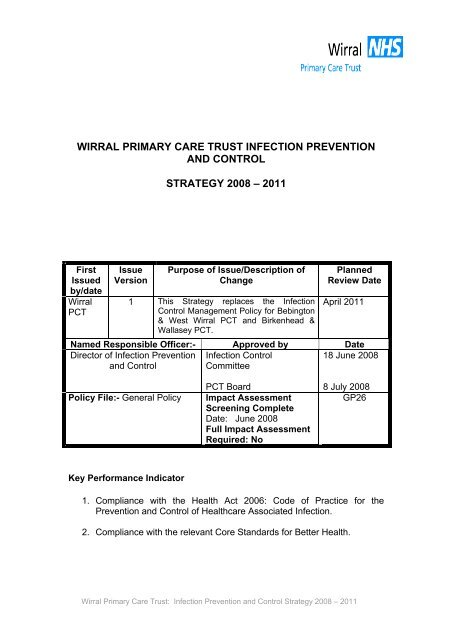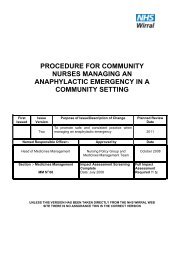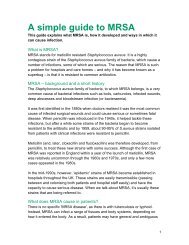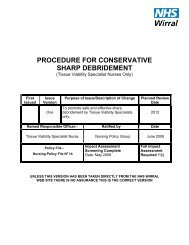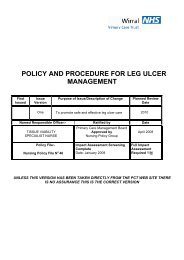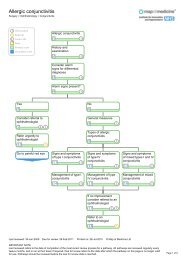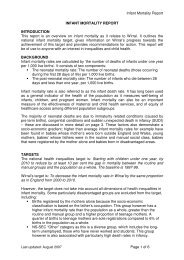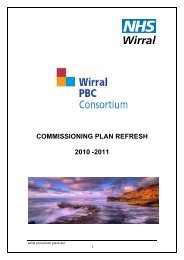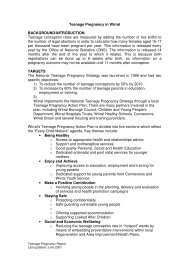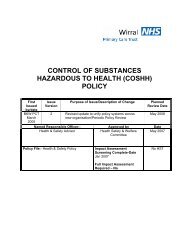wirral primary care trust infection prevention and ... - NHS North West
wirral primary care trust infection prevention and ... - NHS North West
wirral primary care trust infection prevention and ... - NHS North West
You also want an ePaper? Increase the reach of your titles
YUMPU automatically turns print PDFs into web optimized ePapers that Google loves.
WIRRAL PRIMARY CARE TRUST INFECTION PREVENTION<br />
AND CONTROL<br />
STRATEGY 2008 – 2011<br />
First<br />
Issued<br />
by/date<br />
Wirral<br />
PCT<br />
Issue<br />
Version<br />
Purpose of Issue/Description of<br />
Change<br />
1 This Strategy replaces the Infection<br />
Control Management Policy for Bebington<br />
& <strong>West</strong> Wirral PCT <strong>and</strong> Birkenhead &<br />
Wallasey PCT.<br />
Planned<br />
Review Date<br />
April 2011<br />
Named Responsible Officer:- Approved by Date<br />
Director of Infection Prevention Infection Control<br />
18 June 2008<br />
<strong>and</strong> Control<br />
Committee<br />
Policy File:- General Policy<br />
PCT Board<br />
Impact Assessment<br />
Screening Complete<br />
Date: June 2008<br />
Full Impact Assessment<br />
Required: No<br />
8 July 2008<br />
GP26<br />
Key Performance Indicator<br />
1. Compliance with the Health Act 2006: Code of Practice for the<br />
Prevention <strong>and</strong> Control of Health<strong>care</strong> Associated Infection.<br />
2. Compliance with the relevant Core St<strong>and</strong>ards for Better Health.<br />
Wirral Primary Care Trust: Infection Prevention <strong>and</strong> Control Strategy 2008 – 2011
Infection Prevention <strong>and</strong> Control Strategy 2008 – 2011<br />
Background<br />
Over the past two decades, health <strong>care</strong> associated <strong>infection</strong>s (HCAI) have<br />
been identified as a significant risk to patient safety. This has a financial cost<br />
to the <strong>NHS</strong> <strong>and</strong> a physical, social, psychological <strong>and</strong> often financial cost to<br />
both patients <strong>and</strong> relatives. Awareness of the risk of health<strong>care</strong> interventions<br />
<strong>and</strong> the potential for acquiring an <strong>infection</strong>, in addition to the <strong>primary</strong> health<br />
<strong>care</strong> need, has increased both in the secondary <strong>and</strong> <strong>primary</strong> <strong>care</strong><br />
environments.<br />
In response to this increasing risk, the Department of Health (DH) has<br />
produced a range of guidance to support organisations in <strong>primary</strong> <strong>and</strong><br />
secondary <strong>care</strong> to manage these risks:<br />
• Getting ahead of the Curve – a strategy for combating infectious<br />
diseases (DH 2002)<br />
• Winning Ways: working together to reduce HCAI in Engl<strong>and</strong> (DH<br />
2003)<br />
• The National Programme for Decontamination – National<br />
St<strong>and</strong>ards – Local Delivery (DH 2003)<br />
• Saving lives: a delivery programme to reduce HCAI (Secondary<br />
Care) (DH 2005)<br />
• The Code of Practice for the Prevention <strong>and</strong> Control of HCAI (DH<br />
2006)<br />
• Essential Steps to Safe Clean Care: Reducing HCAI (2006)<br />
• Core St<strong>and</strong>ards for Better Health (Health<strong>care</strong> Commission 2006)<br />
• The Safe Management of Health<strong>care</strong> Waste (2006) Environment<br />
<strong>and</strong> Sustainability Technical Memor<strong>and</strong>um 07 – 01<br />
• Clean, safe <strong>care</strong>: Reducing <strong>infection</strong>s <strong>and</strong> saving lives (DH 2008)<br />
• Going Further Faster II: applying the learning to reduce HCAI <strong>and</strong><br />
improve cleanliness (DH 2008)<br />
From October 2006, the Health Act was amended to include the Code of<br />
Practice for the Prevention <strong>and</strong> Control of Health<strong>care</strong> Associated Infections,<br />
(frequently referred to as the Hygiene Code) to ensure that the <strong>prevention</strong> of<br />
health<strong>care</strong> associated <strong>infection</strong>s is embedded in all health<strong>care</strong> provided in the<br />
health economy. This legislation now forms the spine of all st<strong>and</strong>ards,<br />
assessments, policy <strong>and</strong> guidance issued to health<strong>care</strong> organisations.<br />
The Health<strong>care</strong> Commission (HCC) is tasked with monitoring all <strong>NHS</strong><br />
organisations in relation to core st<strong>and</strong>ards which incorporates the Code of<br />
Practice. The HCC will undertake announced <strong>and</strong> unannounced inspections<br />
as part of the monitoring process to assess compliance.<br />
Wirral Primary Care Trust: Infection Prevention <strong>and</strong> Control Strategy 2008 – 2011:<br />
Page 1 of 21
Purpose <strong>and</strong> Scope of the Strategy<br />
The purpose of this strategy is to ensure that the PCT demonstrates its<br />
commitment to patient safety <strong>and</strong> compliance with the Health Act 2006. This<br />
strategy will help to ensure that effective <strong>infection</strong> <strong>prevention</strong> <strong>and</strong> control is<br />
embedded into the everyday practice of all provider, contracted <strong>and</strong><br />
commissioned services <strong>and</strong> is applied consistently across the organisation.<br />
The strategy will establish ownership of <strong>infection</strong> <strong>prevention</strong> <strong>and</strong> control at all<br />
levels of the organisation from the Trust Board to individual clinicians<br />
providing health<strong>care</strong>. All staff have a duty to comply with best practice in<br />
<strong>infection</strong> <strong>prevention</strong> <strong>and</strong> as part of their job descriptions within PCT salaried<br />
staff.<br />
To support the PCT, the Infection Prevention <strong>and</strong> Control Service will remain<br />
within the Provider Service arm but will have a dual function to support <strong>and</strong><br />
monitor PCT provider <strong>and</strong> contractor services <strong>and</strong> also to provide specialist<br />
advice <strong>and</strong> support to the PCT Commissioning team.<br />
This Strategy replaces the Infection Control Management Policy for Bebington<br />
<strong>and</strong> <strong>West</strong> Wirral PCT <strong>and</strong> Birkenhead <strong>and</strong> Wallasey PCT to reflect the wider<br />
responsibilities of the PCT through provider <strong>and</strong> commissioning functions.<br />
Provider Services<br />
The strategy will enable the delivery of <strong>infection</strong> control st<strong>and</strong>ards <strong>and</strong> ensure<br />
that safe practice is embedded in the culture of services <strong>and</strong> clinical teams,<br />
through robust performance management <strong>and</strong> development processes.<br />
Ownership of <strong>infection</strong> <strong>prevention</strong> <strong>and</strong> control practice will be at both<br />
management <strong>and</strong> clinical levels. Compliance with the Code will be included in<br />
the Provider Service contract in 2008. Service Level Agreements will also<br />
include a requirement to comply with the Health Act 2006. MRSA bacteraemia<br />
rates will be monitored on a monthly basis by Commissioning; monitoring will<br />
be increased if there is an ongoing variance over the agreed trajectory.<br />
Compliance with the duties outlined in the Code of Practice will be monitored<br />
annually.<br />
Commissioned <strong>and</strong> Contracted Services<br />
The principles of this strategy will be included in services that are<br />
commissioned <strong>and</strong> contracted.<br />
Wirral PCT is the Lead commissioner for:<br />
• Wirral University Teaching Hospital <strong>NHS</strong> Foundation Trust (WUTH)<br />
• Clatterbridge Centre for Oncology <strong>NHS</strong> Foundation Trust (CCO)<br />
• Cheshire <strong>and</strong> Wirral Partnership <strong>NHS</strong> Foundation Trust (CWP)<br />
Wirral Primary Care Trust: Infection Prevention <strong>and</strong> Control Strategy 2008 – 2011:<br />
Page 2 of 21
The PCT will ensure arrangements are in place through the Service Level<br />
Agreements (SLAs) for rigorous performance management of levels of HCAI.<br />
The PCT expects the Lead commissioning PCT for other Trusts with which it<br />
commissions <strong>care</strong> to monitor st<strong>and</strong>ards on Wirral PCT’s behalf.<br />
Independent contractors - the appropriate st<strong>and</strong>ards of the Code of Practice<br />
will be introduced into the appropriate quality st<strong>and</strong>ards via the GMS/PMS<br />
contracting process as new legislation is introduced. Self-assessments<br />
against the st<strong>and</strong>ards will be expected within GP practices. To ensure<br />
consistency, the assessment tool within Essential Steps to Safe Clean Care<br />
will be the expected process. Other Independent Contractors will use best<br />
practice guidance developed for these services. All services will also be<br />
required to meet any professional guidance <strong>and</strong> advice relating to HCAIs as<br />
issued by their professional organisations.<br />
Compliance with the principles of the Health Act will be included within<br />
accreditation st<strong>and</strong>ards contract for locally enhanced services, new <strong>NHS</strong> <strong>and</strong><br />
non <strong>NHS</strong> services.<br />
Secondary <strong>care</strong> services commissioned by the PCT have a duty to comply<br />
with the Health Act. The PCT will monitor performance by the contracting<br />
process <strong>and</strong> formal partnerships. These providers will be expected to have in<br />
place a programme or action plans to demonstrate progress towards meeting<br />
the st<strong>and</strong>ards <strong>and</strong> targets i.e. MRSA bacteraemias <strong>and</strong> Clostridium difficile<br />
cases in-patients over 2 years of age; agreed against key indicators <strong>and</strong> these<br />
will be monitored on a monthly basis.<br />
The PCT will be notified of any reviews undertaken by the Health<strong>care</strong><br />
Commission <strong>and</strong> of the findings of such reviews <strong>and</strong> will closely monitor<br />
subsequent action plans.<br />
Partnership Working<br />
This strategy sets out the arrangements, responsibilities <strong>and</strong> a plan for<br />
<strong>infection</strong> <strong>prevention</strong> <strong>and</strong> control within Wirral PCT for 2008 – 2011. This will<br />
include close communication <strong>and</strong> partnership working with:<br />
• Wirral University Teaching Hospital <strong>NHS</strong> Foundation Trust (WUTH)<br />
• Clatterbridge Centre for Oncology <strong>NHS</strong> Foundation Trust (CCO)<br />
• Health Protection Agency (HPA) Cheshire & Merseyside Health<br />
Protection Unit<br />
• Cheshire <strong>and</strong> Wirral Partnership <strong>NHS</strong> Foundation Trust (CWP)<br />
Public Health<br />
The PCT Health Protection Strategy (which will feed into the Health <strong>and</strong><br />
Social Care Strategy) is currently under development. This will provide current<br />
<strong>and</strong> future direction of Health Protection for the Wirral Health Economy. The<br />
Infection Prevention <strong>and</strong> Control service are responsible for management <strong>and</strong><br />
Wirral Primary Care Trust: Infection Prevention <strong>and</strong> Control Strategy 2008 – 2011:<br />
Page 3 of 21
control of communicable diseases (other than Tuberculosis) through contact<br />
tracing <strong>and</strong> outbreak management. However, as the overarching responsibility<br />
for communicable disease <strong>prevention</strong> <strong>and</strong> management lies with Public Health<br />
Directorate there will be ongoing partnership working to prevent duplication or<br />
omission between the three strategies. This Strategy will be reviewed <strong>and</strong><br />
updated as required to ensure a seamless service.<br />
Health Protection Agency (HPA) - Cheshire & Merseyside<br />
Health Protection Unit<br />
Full clarity of the HPA’s functions <strong>and</strong> responsibilities will be provided by a<br />
new framework specification “Forward thinking, Future Working”. This<br />
document will identify local <strong>and</strong> regional HPA service provision for 2007 –<br />
2010. Publication is expected spring 2008.<br />
The HPA currently:<br />
• Supports the commissioning role of PCT’s<br />
• Ensures that all parts of the country are served by resilient, skilled<br />
<strong>and</strong> nationally quality-assured health protection teams <strong>and</strong> have<br />
access to microbiology <strong>and</strong> environmental hazards services that<br />
meet the needs of the PCT as a local stakeholder.<br />
• Ensures that Health Protection Specialist/Consultant response <strong>and</strong><br />
support is available to the PCT twenty four hours a day, seven days<br />
a week.<br />
Strategy for Infection Prevention <strong>and</strong> Control<br />
Key Actions to be implemented during 2008 – 2011. Progress with these<br />
actions will be monitored by the Board.<br />
Strategic responsibilities:<br />
Wirral PCT is required to assure itself that all commissioned services are<br />
achieving:<br />
• Compliance with the Health Act 2006.<br />
• Compliance with the appropriate Core St<strong>and</strong>ards for Better Health<br />
<strong>and</strong> <strong>NHS</strong>LA risk management st<strong>and</strong>ards.<br />
• Appropriate governance arrangement <strong>and</strong> lines of accountability<br />
<strong>and</strong> reporting mechanisms for <strong>infection</strong> <strong>prevention</strong> <strong>and</strong> control at<br />
strategic <strong>and</strong> operational level.<br />
• Compliance by WUTH to ensure that Department of Health<br />
requirements are met; which currently include trajectory figures for<br />
the reduction of MRSA Bacteraemia <strong>and</strong> Clostridium difficile, as per<br />
agreed local Targets.<br />
• Root Cause Analysis for all MRSA bacteraemias identified from<br />
<strong>primary</strong> <strong>and</strong> secondary <strong>care</strong>.<br />
Wirral Primary Care Trust: Infection Prevention <strong>and</strong> Control Strategy 2008 – 2011:<br />
Page 4 of 21
• Provision of cleaning services for all PCT premises which work to<br />
the appropriate National Cleaning St<strong>and</strong>ards<br />
• Inclusion of compliance with the Code of Practice in all provider<br />
SLAs.<br />
• Inclusion of <strong>infection</strong> <strong>prevention</strong> <strong>and</strong> control in all job descriptions at<br />
all levels of the organisation.<br />
Provider services responsibilities:<br />
• Implementation of ‘Essential Steps to Safe Clean Care’ into clinical<br />
practice<br />
• Implementation of Community Clean Your H<strong>and</strong>s campaign<br />
• Work with key <strong>infection</strong> <strong>prevention</strong> <strong>and</strong> control staff in the<br />
completion of a Root Cause Analysis for a pre 48 hour MRSA<br />
bacteraemia associated with their service.<br />
• To report pre 48hour MRSA bacteraemias as serious <strong>and</strong> untoward<br />
events.<br />
• Maintain close working relationships with the Infection Prevention<br />
<strong>and</strong> Control Team for the development <strong>and</strong> management of all<br />
existing <strong>and</strong> new facilities, builds <strong>and</strong> services.<br />
• To advise <strong>and</strong> work with the decontamination lead to ensure that<br />
the risks associated with reusable equipment are minimised.<br />
• Work closely with <strong>infection</strong> control, health <strong>and</strong> safety, governance<br />
<strong>and</strong> risk management teams to ensure that service <strong>and</strong> practice<br />
HCAI risks are assessed, recorded <strong>and</strong> minimised.<br />
• Reporting of HCAI related clinical incidents through appropriate<br />
channels.<br />
• Work closely with <strong>infection</strong> control in the audit of policies <strong>and</strong><br />
practice with a potential for HCAI, <strong>and</strong> the development of remedial<br />
treatment plans where required.<br />
• Participate actively in the Infection Control Committee <strong>and</strong> the<br />
development of service action plans to address the code of<br />
practice.<br />
• Provision of timely reports to relevant groups <strong>and</strong> the Director of<br />
Infection Prevention <strong>and</strong> Control as required.<br />
• Ensure all staff involved in patient <strong>care</strong> or treatment receives<br />
appropriate training in <strong>infection</strong> <strong>prevention</strong> policies <strong>and</strong> practice on<br />
commencement with the PCT <strong>and</strong> every 2 years following this.<br />
• Inclusion of <strong>infection</strong> <strong>prevention</strong> <strong>and</strong> control in all personal<br />
development reviews.<br />
Policy Development <strong>and</strong> Implementation<br />
• Key policies <strong>and</strong> procedures should be reviewed <strong>and</strong> implemented<br />
on a set timescale <strong>and</strong> in light of new <strong>and</strong> relevant research.<br />
• Policies for PCT Services <strong>and</strong> General Practice to be combined to<br />
ensure consistent st<strong>and</strong>ards <strong>and</strong> information.<br />
Wirral Primary Care Trust: Infection Prevention <strong>and</strong> Control Strategy 2008 – 2011:<br />
Page 5 of 21
Audit<br />
• Development of a rolling programme of audit of compliance with<br />
Infection control policy <strong>and</strong> practice.<br />
• Monitoring of audit programme through governance structure.<br />
• Primary <strong>care</strong> providers i.e. General Dental Providers <strong>and</strong> General<br />
Practice are currently consulting on an appropriate audit process<br />
for practices which will be in line with their governance structures.<br />
Risk Assessment <strong>and</strong> Management<br />
Patients have a right to clean safe treatment wherever <strong>and</strong> whenever they are<br />
treated by the <strong>NHS</strong> (DoH Clean Safe Care: Reducing Infections <strong>and</strong> Saving<br />
Lives, January 2008). Whilst people are most likely to acquire a HCAI during<br />
treatment in a secondary <strong>care</strong> hospital, they can also occur in <strong>primary</strong> <strong>care</strong>,<br />
anywhere that people are receiving clinical procedures; clinics, surgeries,<br />
patients own home or <strong>care</strong> home. Patients are discharged from secondary<br />
<strong>care</strong> faster <strong>and</strong> interventions are increasing in complexity <strong>and</strong> diversity, risk to<br />
the patient is increasing. Staff are also at risk of HCAIs as more invasive<br />
procedures are performed in <strong>primary</strong> <strong>care</strong>.<br />
Ensuring the risk of health<strong>care</strong> associated <strong>infection</strong> (HCAI) is conducted <strong>and</strong><br />
recorded at all levels of the PCT, with risk reduction strategies identified<br />
where required. This will be achieved by:<br />
• Risk Management Strategy<br />
• Risk Assessment for the Prevention <strong>and</strong> Control of HCAI Guidance<br />
• Inclusion in the corporate risk register<br />
• Risk assessment of all clinical provider services (Appendix A)<br />
• Training on local HCAI risk assessment process given in training.<br />
• Procedure assessment for clinic based <strong>care</strong><br />
• Patient risk assessment for home <strong>care</strong><br />
• The development of the risk assessment process throughout<br />
General Practice <strong>and</strong> General Dental Practice.<br />
• Monitoring of <strong>infection</strong> control risks reported through incident<br />
reporting system<br />
• Monitoring of community associated MRSA bacteraemias through<br />
governance as an untoward incident.<br />
Antibiotic Prescribing Management<br />
Antibiotic prescribing management steps are taken to engage prescribers in<br />
the rational <strong>and</strong> cost-effective use of antibiotics by <strong>primary</strong> <strong>care</strong> prescribers.<br />
The overall aim is to reduce the emergence of antibiotic resistance <strong>and</strong><br />
reduce the risk of inappropriate prescribing precipitating health <strong>care</strong><br />
associated <strong>infection</strong>s, such as Clostridium difficile. The Medicines<br />
Management Team monitors prescribing <strong>and</strong> provides a range of support:-<br />
Wirral Primary Care Trust: Infection Prevention <strong>and</strong> Control Strategy 2008 – 2011:<br />
Page 6 of 21
• provision <strong>and</strong> annual update of <strong>primary</strong> <strong>care</strong> anti-microbial<br />
guidelines<br />
• educational strategies supported by the Microbiology Department<br />
at WUTH<br />
• audit <strong>and</strong> prescribing analysis to promote adherence to the <strong>primary</strong><br />
<strong>care</strong> guidelines<br />
• provision of patient information materials to utilise during<br />
consultations<br />
• participation in public campaigns to influence patient expectation<br />
<strong>and</strong> increase awareness of the risks of unnecessary antibiotic<br />
prescribing<br />
Education <strong>and</strong> Training<br />
An essential step in protecting patients <strong>and</strong> staff from HCAI means that all<br />
health<strong>care</strong> staff undertake procedures correctly every time for every patient, in<br />
every health<strong>care</strong> setting. The PCT has a responsibility:<br />
• To ensure <strong>infection</strong> <strong>prevention</strong> <strong>and</strong> control is part of the<br />
organisation’s m<strong>and</strong>atory training <strong>and</strong> induction programme.<br />
• To ensure there is a system in place to provide training to new<br />
starters in contracted services <strong>and</strong> m<strong>and</strong>atory updating.<br />
Patient <strong>and</strong> Public Information <strong>and</strong> Education<br />
• To ensure information is available to patients <strong>and</strong> the public on the<br />
PCT’s commitment to health <strong>care</strong> associated <strong>infection</strong> <strong>prevention</strong>,<br />
outlining the methods by which this will be achieved.<br />
• To ensure information is available to patients <strong>and</strong> the public on<br />
common <strong>infection</strong>s including health <strong>care</strong> associated <strong>infection</strong>s e.g.<br />
MRSA, Clostridium difficile.<br />
• To ensure information is available through different communication<br />
mediums e.g., paper based, internet, person to person.<br />
PCT Structures<br />
Governance Arrangements:<br />
• The PCT will ensure that there are robust governance<br />
arrangements in place with delegated responsibility <strong>and</strong><br />
accountability to ensure that the strategy is implemented.<br />
• Prevention of HCAI <strong>infection</strong>s will be identified in all PCT key<br />
documents, plans <strong>and</strong> agreements e.g. PCT Operational Plan,<br />
Provider Service Level Agreements.<br />
Wirral Primary Care Trust: Infection Prevention <strong>and</strong> Control Strategy 2008 – 2011:<br />
Page 7 of 21
Director of Infection Prevention <strong>and</strong> Control (DIPC):<br />
This is a Senior Clinician, currently the Medical Director for Salaried Services.<br />
• Duties of the PCT DIPC are clearly identified in the Job Description<br />
• The PCT DIPC reports directly to the Chief Executive <strong>and</strong> has<br />
direct access to the Board<br />
• Is responsible for the Infection Prevention <strong>and</strong> Control Team within<br />
the PCT<br />
• Is an integral member of the PCT’s governance <strong>and</strong> patient safety<br />
structure<br />
• Oversees the implementation of <strong>infection</strong> <strong>prevention</strong> <strong>and</strong> control<br />
action plans <strong>and</strong> policies.<br />
• Has authority to challenge behaviour which is not consistent with<br />
the provision of safe clean <strong>care</strong> within the PCT.<br />
• Produces an annual report which is available to the public on the<br />
PCT’s progress towards compliance with national st<strong>and</strong>ards <strong>and</strong><br />
targets; annually presenting this to the Board for ratification.<br />
• Oversees HCAI <strong>prevention</strong> <strong>and</strong> control in commissioned <strong>and</strong><br />
contracted services.<br />
Infection Prevention <strong>and</strong> Control Team:<br />
A nurse led service consisting of 3 WTE Infection Prevention <strong>and</strong> Control<br />
Specialists. Duties include:<br />
• The monitoring of <strong>infection</strong>, <strong>prevention</strong> <strong>and</strong> control practices across<br />
PCT provider services <strong>and</strong> contracted services.<br />
• Acting as specialist advisors to PCT provider services,<br />
commissioned services <strong>and</strong> other health <strong>and</strong> social <strong>care</strong> providers<br />
in the Wirral health economy.<br />
• Lead the root cause analysis process for all pre 48hour MRSA<br />
bacteraemias within the Wirral health economy <strong>and</strong> ensure results<br />
are reported through the appropriate governance system.<br />
• Provide the specialist knowledge for induction <strong>and</strong> training across<br />
the health economy where appropriate.<br />
• To co-ordinate outbreak management to PCT providers, contracted<br />
services <strong>and</strong> other health <strong>and</strong> social <strong>care</strong> providers.<br />
• To co-ordinate communicable disease control in conjunction with<br />
the HPA.<br />
• Overseeing the audit rolling programme, ensuring adequate <strong>and</strong><br />
timely feedback to services where appropriate.<br />
Wirral Primary Care Trust: Infection Prevention <strong>and</strong> Control Strategy 2008 – 2011:<br />
Page 8 of 21
Infection Prevention Champions PCT Provider Services:<br />
Duties include:<br />
• Representation of service at the Infection Control Committee.<br />
• Responsible for ensuring completion of service <strong>and</strong> procedure risk<br />
assessments.<br />
• Report any outst<strong>and</strong>ing service/procedure HCAI risk assessment<br />
issues.<br />
• Responsible for ensuring service action plan is completed to<br />
achieve compliance with Code of Practice.<br />
Infection Control Committee:<br />
• Oversee the implementation of the strategy <strong>and</strong> Code of Practice<br />
<strong>and</strong> all overarching <strong>infection</strong> control business for provider <strong>and</strong><br />
contractor services.<br />
• Make decisions on all <strong>infection</strong> control issues <strong>and</strong> adverse<br />
incidents.<br />
• Provide advice to the <strong>infection</strong> control team, DIPC <strong>and</strong> the PCT<br />
Board.<br />
• Report anonymous audit findings, adverse incidents <strong>and</strong> quarterly<br />
updates to the Integrated Governance Committee, Corporate<br />
Directors Group (CDG) <strong>and</strong> the Board.<br />
• Ratifies PCT Infection Prevention <strong>and</strong> Control Policies <strong>and</strong><br />
Guidance.<br />
• Reports to the Patient Safety <strong>and</strong> Learning from Experience Group.<br />
Lead Manager for Cleaning:<br />
• Oversee the SLA for cleaning services to the PCT.<br />
• Ensure contracted service work to the National Patient Safety<br />
Association (NPSA) Specifications for Cleanliness in the <strong>NHS</strong> for<br />
community services when published (Summer 2008).<br />
• Update the Infection Control Committee of results of st<strong>and</strong>ards<br />
monitoring.<br />
• Ensuring patients <strong>and</strong> public are aware of cleaning st<strong>and</strong>ards <strong>and</strong><br />
frequencies in PCT clinical areas.<br />
Lead Manager for Decontamination<br />
• Oversee the completion of the Decontamination Strategy.<br />
• Provide quarterly updates to the Infection Control Committee.<br />
Wirral Primary Care Trust: Infection Prevention <strong>and</strong> Control Strategy 2008 – 2011:<br />
Page 9 of 21
Delivery of the Strategy<br />
This will be through:<br />
• The Infection Control Programme<br />
The PCT Board will evaluate the effectiveness of Infection Control Systems<br />
annually through the Infection Control Annual Report <strong>and</strong> the Action Plan.<br />
• PCT Business Planning Processes<br />
Successful delivery of this strategy requires strong <strong>and</strong> effective<br />
communication at all levels of the organisation ensuring all staff are aware of<br />
their responsibility within this strategy.<br />
• Essential Steps to Safe Clean Care Programme<br />
• Training <strong>and</strong> Education<br />
Ensuring staff have an informed level of knowledge to prevent <strong>and</strong> manage<br />
HCAI <strong>and</strong> ensuring that practical skills are assessed <strong>and</strong> not assumed. These<br />
processes will increase workforce risk awareness <strong>and</strong> <strong>infection</strong> <strong>prevention</strong><br />
practice. This will ensure the PCT has a highly skilled workforce providing<br />
safe, clean <strong>care</strong>.<br />
• Risk Assessment<br />
Ongoing assessment of HCAI risk assessment conducted by all clinical<br />
provider services for current <strong>and</strong> new health<strong>care</strong> demonstrating risk reduction<br />
strategies where possible.<br />
• Infection Control Team<br />
The Infection Control Team is integral to the successful communication,<br />
delivery <strong>and</strong> review of the strategy <strong>and</strong> will be responsible for providing<br />
support <strong>and</strong> guidance to assist with compliance, identifying <strong>and</strong> reporting<br />
areas of non-compliance <strong>and</strong> identifying <strong>and</strong> alerting the PCT to changing<br />
priorities if <strong>and</strong> when necessary.<br />
• Provider <strong>and</strong> Contracted Services<br />
Inclusion <strong>and</strong> ownership of this strategy within provider services is essential<br />
for successful outcome.<br />
• Antibiotic prescribing management <strong>and</strong> monitoring<br />
The Medicines Management Team has a key role in providing ongoing<br />
monitoring <strong>and</strong> provision of educational support to promote rational antibiotic<br />
use <strong>and</strong> reduce risk of health<strong>care</strong> associated <strong>infection</strong>s.<br />
• Ongoing PCT performance monitoring<br />
Monitoring of MRSA <strong>and</strong> Clostridium difficile rates <strong>and</strong> associated action plans<br />
for the PCT <strong>and</strong> WUTH as directed by the Department of Health, PCT<br />
provider <strong>and</strong> contractor services training attendance. Satisfactory external<br />
performance monitoring reports e.g. <strong>NHS</strong>LA, Health Care Commission.<br />
Wirral Primary Care Trust: Infection Prevention <strong>and</strong> Control Strategy 2008 – 2011:<br />
Page 10 of 21
References <strong>and</strong> Bibliography<br />
1. Department of Health (2002) Getting ahead of the curve. A strategy for<br />
combating infectious diseases. London. DH Crown copyright.<br />
2. Department of Health (2003) Winning ways: working together to reduce<br />
health<strong>care</strong> associated <strong>infection</strong> in Engl<strong>and</strong>. London. DH Crown<br />
copyright.<br />
3. Department of Health (2003) EC Directive Medical Devices Directive –<br />
93/42/EEC<br />
4. Department of Health (2005) Saving lives: a delivery programme to<br />
reduce health<strong>care</strong> associated <strong>infection</strong> (HCAI) London. DH Crown<br />
copyright<br />
5. Department of Health (2006) Essential steps to safe, clean <strong>care</strong>:<br />
Reducing health<strong>care</strong> associated <strong>infection</strong>. London. DH Crown copyright<br />
6. Department of Health (2006) Environment <strong>and</strong> Sustainability Health<br />
Technical Memor<strong>and</strong>um 07-01, Safe Management of Health<strong>care</strong> Waste.<br />
London Crown copyright.<br />
7. Department of Health (2006) (reviewed 2008) The Health Act. Code of<br />
practice for the <strong>prevention</strong> <strong>and</strong> control of health<strong>care</strong> associated<br />
<strong>infection</strong>s. DH Crown copyright.<br />
8. Infection Control Nurses Association (2005) Audit tool for monitoring<br />
<strong>infection</strong> control st<strong>and</strong>ards in <strong>primary</strong> <strong>and</strong> community <strong>care</strong>. ICNA<br />
(guidance)<br />
9. HSE (1974) Health <strong>and</strong> Safety at Work etc Act 1974.<br />
10. Department of Health (2008) Clean, Safe Care: Reducing Infections <strong>and</strong><br />
Saving Lives. London. DH Crown copyright.<br />
11. Department of Health (2008) Going Further Faster II: applying the<br />
learning to reduce HCAI <strong>and</strong> improve cleanliness. London. DH. Crown<br />
copyright.<br />
Wirral Primary Care Trust: Infection Prevention <strong>and</strong> Control Strategy 2008 – 2011:<br />
Page 11 of 21
Appendix A<br />
Risk Assessment for the Prevention <strong>and</strong> Control of Health<strong>care</strong><br />
Associated Infections (HCAI) Guidance.<br />
Introduction<br />
Any infectious agent acquired by a patient through health <strong>care</strong> treatment or by<br />
a health<strong>care</strong> worker through their health<strong>care</strong> duties is a health<strong>care</strong> associated<br />
<strong>infection</strong>. Effective <strong>prevention</strong> <strong>and</strong> control of infectious agents must be<br />
embedded into everyday practice <strong>and</strong> applied consistently. Crucial to this is<br />
the identification of risk in health<strong>care</strong> practice <strong>and</strong> the adoption of measures to<br />
remove or control such risks. As with any risk assessment process these risks<br />
must be recorded, acted on <strong>and</strong> monitored to ensure high st<strong>and</strong>ards of<br />
<strong>infection</strong> <strong>prevention</strong> in practice.<br />
Guidance Aim<br />
The aim of this guidance is to assist PCT services in the risk assessment<br />
process for PCT health<strong>care</strong> services, health<strong>care</strong> environments <strong>and</strong> specific<br />
procedures for health <strong>care</strong> associated Infections (HCAI).<br />
Independent contractors are responsible for the management of risks within<br />
their practice. To support them in this duty this guidance is available as an<br />
example of best practice.<br />
Guidance outcome<br />
All PCT services will conduct risk assessments of their service. Risk<br />
assessments of clinical <strong>care</strong> environments <strong>and</strong> specific procedures will be<br />
performed according to the risks identified in the service risk assessment.<br />
Target group<br />
All PCT clinical services<br />
Shared as best practice with Independent General Practices <strong>and</strong> General<br />
Dental Practices.<br />
Cross reference related PCT policies<br />
• HS9 Risk Assessment Policy<br />
• GP5 Risk Management Strategy<br />
• GP26 Wirral PCT Infection Prevention <strong>and</strong> Control Strategy (in<br />
draft)<br />
Wirral Primary Care Trust: Infection Prevention <strong>and</strong> Control Strategy 2008 – 2011:<br />
Page 12 of 21
Background<br />
The PCT has a legal requirement through the Health Act 2006 to assess the<br />
risks of patients acquiring health <strong>care</strong> associated <strong>infection</strong>s <strong>and</strong> to take action<br />
to reduce or control such risks. The PCT has a duty to ensure that it has:<br />
a. made suitable <strong>and</strong> sufficient assessment of the risks to patients in<br />
receipt of health<strong>care</strong> with respect to HCAIs;<br />
b. identified the steps that need to be taken to reduce or control those<br />
risks;<br />
c. recorded its findings in relation to (a) <strong>and</strong> (b);<br />
d. implemented the steps identified; <strong>and</strong><br />
e. have appropriate methods in place to monitor the risks of <strong>infection</strong><br />
such that it is able to determine whether further steps need to be<br />
taken to reduce or control HCAIs.<br />
Duty 3, Health Act 2006.<br />
Compliance with this duty will be through Health<strong>care</strong> St<strong>and</strong>ards Assessment<br />
<strong>and</strong> monitoring by the Health<strong>care</strong> Commission.<br />
HCAI Risk Management Processes<br />
HCAI risk can be managed through the following systems:<br />
• Risk Management Strategy<br />
• Risk registers<br />
The risk of health<strong>care</strong> associated <strong>infection</strong> to the organisation as a provider of<br />
health<strong>care</strong> services can be assessed through:<br />
• Corporate risk register<br />
• Service risk register for those services providing or supporting<br />
clinical <strong>care</strong><br />
These must be completed by the Service Lead <strong>and</strong> reviewed on a regular<br />
basis.<br />
• Service assessment<br />
All services must perform an overall risk assessment for the potential of<br />
health<strong>care</strong> associated <strong>infection</strong> occurring <strong>and</strong> determine generalised risk<br />
reduction strategies following st<strong>and</strong>ard <strong>infection</strong> control practice identified in<br />
the Infection Control Policies.<br />
Wirral Primary Care Trust: Infection Prevention <strong>and</strong> Control Strategy 2008 – 2011:<br />
Page 13 of 21
Service risk assessment can be conducted using the documentation <strong>and</strong><br />
process in HS9 Risk Assessment Policy. The following examples may aid<br />
completion.<br />
Hazards:<br />
Procedures/treatments performed in a service where cross <strong>infection</strong> to<br />
patients, staff, contractors, visitors etc could occur i.e. direct patient contact,<br />
contact, invasive procedures, use of sharps, production of hazardous waste,<br />
multi use of equipment etc.<br />
Risks:<br />
What risks could occur if the hazards above were not addressed i.e.<br />
health<strong>care</strong> associated <strong>infection</strong>.<br />
People at risk:<br />
This might be Community Nurse, Physiotherapy assistant, Decontamination<br />
Operative, Patient, General Public, Domestic etc.<br />
Current control measures:<br />
This might be use of polices <strong>and</strong>/or procedures, attendance at training,<br />
provision of h<strong>and</strong> wash facilities, competency training in aseptic technique,<br />
competency training in h<strong>and</strong> decontamination technique, use of sterile single<br />
use equipment, decontamination of equipment between patients etc.<br />
• Clinic/Procedure assessment<br />
Health <strong>care</strong> provided in a <strong>primary</strong> <strong>care</strong> environment is conducted in a variety<br />
of individual clinic settings.<br />
Where a service provides an individual procedure on a large scale these<br />
procedures must be individually assessed for HCAI practice i.e. leg ulcer<br />
treatment, continence assessment clinics, coil fitting, removal of toenails, etc<br />
Staff working in these environments must risk assess their working<br />
environment <strong>and</strong> practice using the generic risk assessment form in HS9.<br />
Appendix A is a risk assessment tool for HCAI which may assist completion<br />
for these environments.<br />
Wirral Primary Care Trust: Infection Prevention <strong>and</strong> Control Strategy 2008 – 2011:<br />
Page 14 of 21
Appendix B is a summary sheet of the actions identified in the proforma for<br />
any procedures or treatment areas with moderate to high risks, use of this<br />
form is optional.<br />
• Individual patient assessment/procedure assessment in a non clinic<br />
environment<br />
Risk assessment for HCAI must be conducted on the first patient contact<br />
following the documentation in HS9 Risk Assessment Policy for <strong>care</strong> provided<br />
in the home environment.<br />
Suggested risk reduction methods that can be used to<br />
minimise the risk of health <strong>care</strong> associated <strong>infection</strong>s.<br />
• All staff providing clinical <strong>care</strong> should be educated about st<strong>and</strong>ard<br />
principles <strong>and</strong> trained in h<strong>and</strong> decontamination, the use of<br />
protective clothing <strong>and</strong> the safe disposal of sharps.<br />
• H<strong>and</strong>s must be decontaminated immediately before each <strong>and</strong><br />
every episode of direct patient <strong>care</strong> <strong>and</strong> after any activity or contact<br />
that could potentially result in h<strong>and</strong>s being decontaminated.<br />
• If h<strong>and</strong>s are visibly soiled use liquid soap <strong>and</strong> water, if not alcoholbased<br />
h<strong>and</strong>rub may be used.<br />
• Use of an effective h<strong>and</strong>washing technique, involving three stages:<br />
washing, rinsing, drying.<br />
• Bare below the elbow <strong>and</strong> removal of h<strong>and</strong> <strong>and</strong> wrist jewellery<br />
when performing clinical duties (wedding b<strong>and</strong> may remain).<br />
• Cover cuts <strong>and</strong> abrasions with waterproof dressings.<br />
• Keep fingernails short <strong>and</strong> free from false mails <strong>and</strong> nail polish.<br />
• Use of gloves for invasive procedures, contact with sterile sites <strong>and</strong><br />
non intact skin, exposure to blood <strong>and</strong> body fluids, secretions or to<br />
contaminated instruments.<br />
• Use of protective plastic aprons when there is a risk that clothing<br />
may be exposed to blood, body fluids, secretions or excretions<br />
(with the exception of sweat).<br />
• Plastic aprons <strong>and</strong> gloves should be worn as single use items.<br />
• Decontamination of equipment <strong>and</strong> medical devices by a method<br />
appropriate to the contamination risk between each use.<br />
Wirral Primary Care Trust: Infection Prevention <strong>and</strong> Control Strategy 2008 – 2011:<br />
Page 15 of 21
New or redesigned service provision <strong>and</strong>/or premises<br />
Risk assessment for HCAI must be completed for all new or redesigned<br />
services or premises as part of the planning process. Guidance for the<br />
health<strong>care</strong> environment can be found in <strong>NHS</strong> Estate Technical Memor<strong>and</strong>ums<br />
<strong>and</strong> guidance.<br />
Governance arrangements<br />
Progress with HCAI risk assessments <strong>and</strong> any action plans developed from<br />
these will be monitored by the Infection Control Committee.<br />
Any high risk practices which cannot adequately be managed should be<br />
reported for consideration by the <strong>infection</strong> control committee.<br />
If risks cannot be minimised they should be recorded in the PCT Service risk<br />
register.<br />
Training<br />
Training in risk assessment is identified in the PCT Training Manual.<br />
Audit<br />
Risk assessments will be monitored as part of the Infection Control rolling<br />
programme of audit.<br />
Specific responsibilities<br />
Service managers are responsible for ensuring that HCAI is included in their<br />
risk register <strong>and</strong> that appropriate risk assessments for HCAIs are completed<br />
<strong>and</strong> reviewed annually or earlier if there are changes to a service or premise.<br />
It is the responsibility of the health<strong>care</strong> worker to identify to the service<br />
manager any unidentified HCAI hazards or practices for risk assessment <strong>and</strong><br />
management.<br />
References<br />
Department of Health (2006) the Health Act 2006: Code of Practice for the<br />
Prevention <strong>and</strong> Control of Health<strong>care</strong> Associated Infections. London. DH<br />
Crown Copyright.<br />
<strong>NHS</strong> Estates (2002) Infection Control in the Built Environment – design <strong>and</strong><br />
planning. The Stationary Office.<br />
Wirral Primary Care Trust: Infection Prevention <strong>and</strong> Control Strategy 2008 – 2011:<br />
Page 16 of 21
Glossary of terms<br />
HCAI - Any <strong>infection</strong> to which an individual may be exposed or made<br />
susceptible to, or more susceptible to, where the risk of exposure or<br />
susceptibility is directly or indirectly attributable to the provision of the health<br />
<strong>care</strong>. The individual who may be at risk may be the individual receiving <strong>care</strong> or<br />
the health<strong>care</strong> worker.<br />
List of those consulted in drafting process<br />
Risk Management<br />
Infection Control Committee<br />
Wirral Primary Care Trust: Infection Prevention <strong>and</strong> Control Strategy 2008 – 2011:<br />
Page 17 of 21
Appendix A: Proforma 1: Risk assessment of <strong>infection</strong> <strong>prevention</strong> <strong>and</strong> control practice in a clinic environment –<br />
<strong>care</strong> is given in a manner which will reduce the potential for health<strong>care</strong> associated <strong>infection</strong>s<br />
Clinical area: Service: Procedure:<br />
Date of first assessment: Date of second assessment:<br />
High risk practice<br />
Tick where high risk practice is found<br />
Lack of adherence to clinical dress code<br />
by staff i.e. wearing jewellery, nail polish,<br />
watches, forearms covered when<br />
performing a clinical procedure.<br />
Health<strong>care</strong> grade liquid soap, paper<br />
towels <strong>and</strong> alcohol h<strong>and</strong>rub not available<br />
H<strong>and</strong> decontamination not performed<br />
before <strong>and</strong> after each episode of patient<br />
contact or activity which could result in<br />
h<strong>and</strong> contamination<br />
Effective h<strong>and</strong> decontamination technique<br />
not followed<br />
Protective clothing not changed between<br />
patients<br />
√ Suggested risk reduction method Comments/revised score<br />
Tick if high- risk practice remains<br />
unchanged<br />
Provide copy of PCT Dress Code Guidance<br />
Ensure supplies are provided by an<br />
appropriate route<br />
Reinforce <strong>and</strong> audit policy<br />
Arrange training with clinical facilitators.<br />
Ensure posters on appropriate technique are<br />
visible for staff<br />
Reinforce <strong>and</strong> audit policy<br />
√<br />
Wirral Primary Care Trust: Infection Prevention <strong>and</strong> Control Strategy 2008 – 2011:<br />
Page 18 of 21
Clinical area: Service: Procedure:<br />
Date of first assessment: Date of second assessment:<br />
High risk practice<br />
Tick where high risk practice is found<br />
√ Suggested risk reduction method Comments/revised score<br />
Tick if high- risk practice remains<br />
unchanged<br />
Aseptic technique not followed Arrange training with clinical facilitators<br />
Sharp items not disposed of immediately Reinforce <strong>and</strong> audit policy<br />
after use into the correct container<br />
Use of individual patient prescribed<br />
Treatments for prescribed patient only<br />
products between patients<br />
Single use equipment reused Reinforce <strong>and</strong> audit policy<br />
Equipment/medical devices not<br />
decontaminated between patients<br />
Total number of high-risk practices<br />
identified in baseline assessment<br />
Review appropriate decontamination<br />
procedures for equipment are known <strong>and</strong><br />
followed<br />
Total number of high-risk<br />
practices remaining after risk<br />
reduction initiatives<br />
√<br />
Wirral Primary Care Trust: Infection Prevention <strong>and</strong> Control Strategy 2008 – 2011:<br />
Page 19 of 21
Appendix B: Proforma 2: Risk assessment summary for high risk procedures/clinics<br />
Provider Service: Date:<br />
Clinic/procedure<br />
Dress code<br />
H<strong>and</strong><br />
decontamination<br />
Protective<br />
clothing<br />
Risk Factors<br />
Aseptic<br />
technique<br />
Sharps<br />
Multi use<br />
products<br />
Decontamination<br />
Risk reduction method(s)<br />
Revised score<br />
Risk assessment undertaken by:<br />
Wirral Primary Care Trust: Infection Prevention <strong>and</strong> Control Strategy 2008 – 2011:<br />
Page 20 of 21


